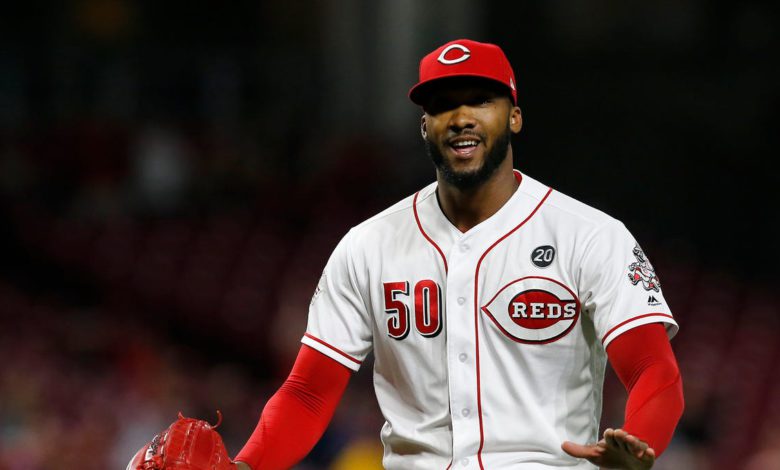
GOODYEAR, Arizona – Many months after watching ESPN’s popular documentary on Michael Jordan, “The Last Dance,” there is a scene that still sticks with Amir Garrett.
Jordan is holding a cigar in his mouth and taking fake swings with a baseball bat while talking to a teammate in the locker room. The Chicago Bulls had lost a playoff game to the Charlotte Hornets the previous night and Jordan, in his practice jersey, explained that he wasn’t worried about the loss.
“The sign of a good man,” Jordan says through the cigar, “is if you can talk (smack) when it’s even score, or talk (smack) when you’re behind score. When you’re ahead, it’s easy to talk.”
By that standard, Garrett might be the best man in baseball. He loves to talk trash. It’s part of his personality. Watch him on the mound in any setting and he’s always showing his confidence.
You know not to mess with him once his name is called over the phone. That’s AG, he’s going in there to kill.”
He was throwing a live batting practice session at the Reds’ spring training complex this spring, facing a rotation of three hitters. It’s as low of stakes as he will have all season. No fans. No fielders behind him. Just a few coaches watching. The purpose for pitchers is just to see hitters in the batter’s box again as they ramp up for actual games.
Garrett, like he usually does, was talking to himself on the mound. “That’s the one right there,” he said after he threw a slider past one hitter. Near the end of his live batting practice session, he told a left-handed hitter to leave the batter’s box, so he could face a right-handed batter one more time.
“Let me go righty,” the left-handed Garrett said from the mound. “I can get you out all day.”
Whether it’s a relatively meaningless live batting practice session or pitching out of a bases-loaded jam with a game on the line, Garrett is always the same Garrett. Or maybe that’s not true. Garrett says the guy on the mound is his alter-ego, “AG.”
“More than I love playing baseball, I love to compete,” Garrett said. “That’s something that can’t be taught.”
Amir Garrett: With an effective slider, 'AG' has become a key Reds pitcher: Here's 3 things to know about lefty Amir Garrett
Garrett, entering his fifth big-league season, has become one of the faces of the Cincinnati Reds. The fanbase has embraced his swagger. He will always be remembered for taking on the Pittsburgh Pirates dugout in a brawl during the 2018 season, the culmination of a season-long feud.
He’s been a reliable reliever for the past three seasons, featuring a mid-90s fastball and a dominant, wipeout slider.
“I like to have the upper hand,” Garrett said. “If you’re facing me, I like to kick you when you’re down. That’s what I want to do. That’s competing, though. I want to win every single time I’m out there.”
Reds pitching: 'If you love this … you have to be willing to pay your dues': How Derek Johnson made it to Cincinnati
Garrett, who played two seasons of college basketball at St. John’s, is more than just a fiery competitor. He’s unafraid to speak out on hot-button issues, hopeful that sharing his perspective will help others and that he can help give a voice for people who feel marginalized.
“The first few years in the big leagues, you’re a little bit timid in a sense,” Garrett said. “You don’t want to do too much. You don’t ever want to be an outcast and you don’t want to be that guy that’s like, ‘look at me.’ I mean, I’m not trying to be that guy. I’m just being me. That’s just how I grew up.”

The brawl against Pittsburgh
The Reds and Pirates feuded throughout the 2019 season, beginning in April when Derek Dietrich admired a home run that he hit into the Allegheny River. He had a pitch thrown behind him in his next at-bat.
The bad blood reached a boiling point on July 30, 2019 when Garrett ran off the mound during a pitching change and charged toward the Pirates dugout. The iconic photo of him cocking his right arm back to throw a punch while surrounded by five Pirates players was shared millions of times. His teammates wore t-shirts with the photo afterward.
When he was escorted off the field after the brawl by a teammate, he flexed his arms and shouted toward the Pirates, “I’m like that!”
“I think people figured out, you can’t just mess with Cincinnati like you think you can,” Garrett said, “and you can’t mess with me like you think you can.”
Garrett was suspended for eight games, but it changed everything for him. He became a well-known player nationally. He received a lot of messages of support from players, coaches and front office staff around the league because he was defending his teammates and he didn’t continue the feud by throwing a pitch at another player; he ended it.
Amir Garrett after Cincinnati Reds-Pirates brawl: 'It was about protecting my teammates'
Amir Garrett was ejected after throwing a punch in a benches-clearing brawl between the Reds and Pirates on Tuesday.
Bobby Nightengale, Cincinnati Enquirer
He had his own transformation, too. He no longer was the young player who was timid. He had the freedom to be himself.
“I think it changed for the better,” Garrett said. “Sometimes, you’ve got to do what you’ve got to do to make a point. I feel like after that day, that really established me as a force in the league.”
Garrett, 28, has always been a gifted athlete. Standing at 6-foot-5, he was one of the top basketball recruits in the country out of high school. His dad convinced him to keep baseball as an option and he stunned scouts as a senior in high school by throwing 96 mph without playing for a year.
Reds baseball: Joey Votto on playing Amir Garrett in basketball: I talked mess to Amir for months, months, months
The Reds drafted him in the 22nd round of the 2011 MLB Draft and gave him a $1 million signing bonus. The gamble paid off when he worked his way to the Major Leagues. He brought the competitive fire that fueled him in basketball to the mound – and, really, everything else in his life.
“That’s just me, man,” he said. “Everybody gets the same Amir. That’s what I say to people. There are some times I play video games with kids, and I realize, ‘Oh, they’re 13, 14 years old. Let me back up a little bit.’”

The voice of Amir Garrett
Garrett knew there would be backlash, but he was OK with that. It was something that he felt strongly about. He consulted his family and told them that he wanted to do it.
He took a knee during the national anthem before two exhibition games and Opening Day last year alongside a couple of teammates. He wrote on Twitter afterward that his decision to take a knee was “based solely on wanting change throughout the country.”
He reiterated that several people close to him served in the military, including his grandfather, knowing that some people will interpret it as disrespecting the flag. He wrote that he wasn’t doing it to push a political opinion and that he didn’t support the Black Lives Matter organization.
I didn’t even get as much backlash as I thought I would. I got a lot more support than I did backlash, and that was an amazing thing, man. It was amazing.”
Garrett, the only Black player on the Reds’ Opening Day roster this year, was overwhelmed by the support he received afterward. There were times the supportive messages brought him to tears, he said, grateful to hear stories from others.
“For me, I’m a realist,” Garrett said. “I accept every single obstacle I have coming my way. Before I do a lot of things, I think about what’s going to happen with my family, my friends, people that are around me. What could be the outcome of this? Are you OK with the outcome?
“As a man, you’ve got to be OK with your decisions, so me kneeling, I knew what the backlash was going to be, but I was OK with the backlash that was going to happen. I didn’t even get as much backlash as I thought I would. I got a lot more support than I did backlash, and that was an amazing thing, man. It was amazing.”
VIDEO: Cincinnati Reds pitcher Amir Garrett shares incident of profiling from 2010
Cincinnati Reds pitcher Amir Garrett shares an incident of profiling from 2010 when he and a friend were pulled over on their way to practice.
Kareem Elgazzar, [email protected]
Spurred by the nationwide protests after George Floyd’s death in Minneapolis, Garrett vowed to use his platform to speak out on issues that were important to him.
He was the teammate that Joey Votto referenced in his op-ed titled, “My Awakening,” urging Votto to watch the video of Floyd’s death.

After a rise in hate crimes against Asian-Americans, Garrett tweeted earlier this month: “I have the back of my Asian American brothers and sisters. I will fight for you guys. Stop the hate!”
When former Reds play-by-play TV broadcaster Thom Brennaman said an anti-gay slur over a hot mic during a Reds game, Garrett immediately tweeted after he heard about it: “To the LGBTQ community just know I am with you, and whoever is against you, is against me. I’m sorry for what was said today.”
“I’m not perfect,” Garrett said. “Nobody else is perfect. Things are going to happen. There should be room for error. There should be and we have cancel culture and stuff like that. When you go through these things, it’s important that we don’t cancel these people because a lot of people make mistakes, but you have to learn from your mistakes, right? I’m just trying to be there for a lot of people who don’t have a voice.”
Garrett hopes that his outspokenness will help other athletes use their platforms and feel comfortable speaking out about issues that matter to them.
“The person that helped me a lot coming up, it’s crazy, Bronson Arroyo,” Garrett said. “He was never rude to me. He was so down-to-earth as a player and as a person. I cling to him because he made me feel comfortable with anything.”
There are teammates who disagree with Garrett’s views. He knows that and he’s OK with that – “Guess what, I still like them at the end of the day,” he said. He doesn’t expect everyone to agree with him, but he says it’s important to have “uncomfortable conversations” at times.
I’m just trying to be there for a lot of people who don’t have a voice.”
“From 2020, what I learned the most with COVID and everything that really happened that year, I have compassion for a lot of people out there,” Garrett said. “I’m in a good stage in my life where I’m able to help people. Not a lot of people get that. When I was a young kid, I was going through these struggles. Now I’m older, successful a little bit and I’m in a better situation. Now I can help others, kids, whatever. I can help a lot of people out here. I’m blessed to be in the position I’m in.”
Amir Garrett: 'I can be a closer'

After the Reds traded longtime closer Raisel Iglesias to the Los Angeles Angels in December for salary relief, Garrett made it known that he wanted to be the team’s closer.
Garrett felt like the job was his to lose and he wanted to speak it into existence. He competed to become the club’s No. 5 starter in the rotation in 2018 and he thought he earned it with the way he pitched in the spring. He was sent to the bullpen anyway.
A little older and a little more experienced, he didn’t want to leave any doubt about whether he deserved to be the closer this spring. He faced 13 hitters in spring training games and struck out 10. He overpowered batters with his slider.
“I wanted to prove a lot of people wrong,” he said. “A lot of people say I can't be a closer, this and that. I know I can. That's what I want to prove. I can be a closer.”
Veteran reliever Sean Doolittle, who signed a one-year deal in February, talked to Garrett early in spring training and told him that he’s been a fan for years. He loves watching Garrett pitch because of the emotion that he shows on the mound.
There is a different energy when Garrett comes running out of the bullpen. Garrett, who takes a fake jump shot once he leaves the bullpen in the outfield, does a leap when he reaches the infield grass. He’ll bob his head when he’s throwing his warm-up pitches and then it’s showtime once the hitter crosses into the batter’s box.
In my experience, it’s good to have a few guys like that in the bullpen that kind of set the tone, set the mentality, not just for the bullpen, but really for the whole team.”
“He has that mentality that you want somebody in the back end of the game to have,” Doolittle said. “In my experience, it’s good to have a few guys like that in the bullpen that kind of set the tone, set the mentality, not just for the bullpen, but really for the whole team.”
The Reds haven’t committed to using Garrett exclusively as a closer, which he figured might happen. He believes that his confidence will elevate himself and his teammates.
Tejay Antone, a rookie pitcher last year, remembers a game when Garrett was sitting in the bullpen and messing with him as usual. Antone turned to him and said, “You better lock it in. You’re about to go in.” Garrett responded that he wasn’t worried because he didn’t think he was going in.
Sure enough, the phone rang, and Garrett was told to start warming up. Just like that, the switch flipped. Amir was gone. This was “AG.”
Amir Garrett wanted to prove 'I can be a closer' in spring training
Amir Garrett, motivated to win the Reds' closer job, struck out 10 of the 13 batters he faced in spring training.
Bobby Nightengale, Cincinnati Enquirer
“He went in there and dominated,” Antone said. “Some guys have more of dial to get locked in. Amir is more of a flip-switcher, and it’s really cool to see. You know not to mess with him once his name is called over the phone. That’s AG, he’s going in there to kill.”
Garrett is an expectant father for a baby girl at the end of the summer and he says his life has already changed. He dreams that one day he’ll be watching the Little League World Series and his name will show up as a kid's favorite player.
He was thrilled when he heard a University of Nebraska pitcher credited him with helping improve his slider by watching an interview that he did.
“That’s what I do this for,” Garrett said. “I know one day I’m going to be out of this game, but I want to leave my impact.”
He’s not a timid young player anymore. He found his voice.
Produced by Joe Harrington, USA TODAY Network
Source link








